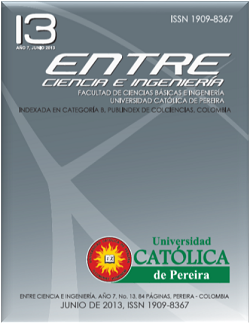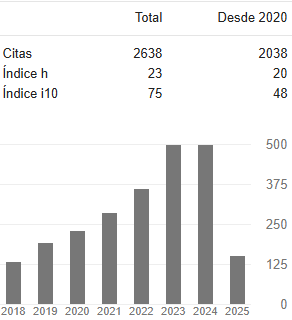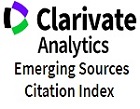Aplicación de un Reactor Electroquímico a Escala Piloto, Operando en Modo Potenciostático para la Regeneración de Baños Agotados de Mordentado
DOI:
https://doi.org/10.31908/19098367.655Palabras clave:
Mordentado, Reactor electroquímico, Rendimiento eléctrico, Tiempo de residencia, Separador cerámicoResumen
En el tratamiento de los baños agotados de mordentado de las industrias de metalizado de plásticos se emplea un reactor electroquímico de tipo filtro-prensa a escala piloto como medio de recuperación del cromo hexavalente, mediante la oxidación del cromo trivalente sobre un ánodo de plomo. Esta investigación se centró en el estudio de un reactor de tal tipo, con el objetivo de estudiar su comportamiento operando en modo potenciostático de 5 y 7.5 V, con soluciones reales de baños de mordentado. Se evaluaron parámetros básicos para el diseño de reactores electroquímicos como son: el rendimiento eléctrico, el grado de conversión alcanzado, la productividad específica y la energía específica consumida, acoplando el reactor electroquímico con uno y dos separadores cerámicos fabricados a 250 kg/cm2 y 0 % de almidón.
Descargas
Referencias
Smith, W. H. and Foreman, T.”Electrowinning/electrostripping and electrodialysis processes for the recovery and recycle of metals from plating rinse solutions”. Separation Science and Technology, 32 pp. 669-679, 1997.
ElSourougy, M. R., Zaky, E. E., and Aly, H. F.”Transport Characteristics of Ceramic Supported Zirconium-Phosphate Membrane. Journal of Membrane Science, 126, pp. 107-113, 1997.
Guddati, S. L., Holsen, T. M., Li, C. C., Selman, J. R., Mandich, N. V. “The use of a porous ceramic diaphragm for the removal of metallic impurities from chromium plating baths”. Journal of Applied Electrochemistry, 29, pp. 1129-1132, 2004.
Pérez-Herranz, V., Guiñón, J. L., García-Antón, J.;“Ingeniería Electroquímica”. Universidad Politécnica de Valencia. SPUPV-97.897, 2002.
Rutherford, A. “ Análisis de Reactores”. Editorial Alhambra. Madrid. 1973.
González-García, J., Frias, A., Expósito, E., Montiel, V. and Aldaz, A.”Development of a Model for Characterization of Electrochemical Reactors”. Industrial Engineering Chemical Research., 39, pp. 1132-1142, 2000.
Benkhelifa, H., Legrand, J., Legemtilhomme, P., Montillet. A. “Study of the hydrodynamic behaviour of the batch and continuous torus reactor in laminar and turbulent flow regimes by means of tracer methods”. Chemical Engineering Science, 55, pp. 1871-1882, 2000.
Pinheiro-Torres, A., Olivera, F. A. R. and Fortuna, S. P. “Residence time distribution of liquids in a continuous tubular thermal processing system part I: Relating RTD to processing conditions”. Journal of Food Engineering, 35, pp. 147- 163, 1998.
Danckwerts, P. V. “Continuous flow systems. Distribution of residence times”. Chemical Engineering Science”, 2, pp. 1-13, 1953.
Tsamatsoulis. D. and Papayannakos, N. “Partial Wetting Of Cylindrical Catalytic Carriers In Trickle-Bed Reactors”. Chemical Engineering Science, 49, pp. 523-529, 1994.
Hasson, D., Drak, A., Komlos, C., Yang, Q., Semiat, R. “Detection of fouling on RO modules by residence time distribution analyses”. Desalination, 204, pp.132-144, 2007.
Doherty, T., Sunderland, J. G., Roberts, E. P. L. and Pickett, D. J. “Electrodeposition of copper ions on fixed bed electrodes: kinetic and hydrodynamic study”. Electrochimica Acta, 41, pp. 519-526, 1996.
Zhang, T., Wan, T., Wang, J. “Flow patterns and wall stresses in a moving granular filter bed with an asymmetric louvered-wall and obstacles”. Chemical Engineering and Processing, 44, pp. 1221- 1227, 2005.
Melo, P. A., Pinto, J. C., Evaristo C., Biscaia, J. “Characterizing a tubular polymerization reactor by washout initiator perturbation”. Chemical Engineering Science, 56, pp. 2703- 2713, 2001.
Sánchez, E., Mestre, S., Pérez-Herranz, V., Reyes, H., Añó, E. “Membrane electrochemical reactor for continuous regeneration of spent chromium plating baths”. Desalination, 200, pp. 668-670, 2006.
M. García-Gabaldón, V. Pérez-Herranz, Henry Reyes. “Regeneration of Hexavalent Chromium from a Simulated Rinse Etching Solution Using an Electrochemical Reactor With Two Compartments Separated by a Ceramic Membrane”. Int. J. Electrochem. Sci., 6, pp 1493 – 1507, 2011.
Pérez-Herranz, V, et al. Chisa 2004. “Regeneration of etching solutions using electrochemical reactors provided with porous ceramic diaphragms”. 16th International Congress of Chemical and Process Engineering, Czech Society of Chemical Engineering, Praga, 2004.
González-García, J., Montiel, V. and Aldaz, A. “Electrochemical characterisation of platinum nanoparticles prepared by microemulsion: how to clean them without loss of crystalline surface structure”. Industrial Engineering Chemical Research., 37, pp. 4501-4511, 1998.
Pérez-Herranz, V., Guiñón, J. L. and García-Antón, J. “Electrochemical recovery of zinc from the spent pickling baths coming from the hot dip galvanizing industry. Potentiostatic operation”. Journal Chemical Engineering Science 54, pp 1667- 1675, 1999.
Mandich, N. V. Li, C. C., and Selman, J. R. “Recovery of metallic impurities from chromium plating solutions by electromigration”. Plating and Surface Finishing, 84, pp. 82-90, 1997.
García-Gabaldón, M., Pérez-Herranz, V., García-Antón, J., Guiñón, J. L. “Electrochemical recovery of tin from the activating solutions of the electroless plating of polymers: Galvanostatic operation”. Separation and Purification Technology. 45, pp. 183-191, 2005.
Bazan, J. C., and Bisang, J. M. “Potential and current distribution in porous electrodes under charge-transfer kinetic control”. Journal of Applied Electrochemistry, 34, pp. 501-506, 2004.
Descargas
Publicado
Número
Sección
Licencia
Derechos de autor 2019 Entre Ciencia e Ingeniería

Esta obra está bajo una licencia internacional Creative Commons Atribución-NoComercial 4.0.



















